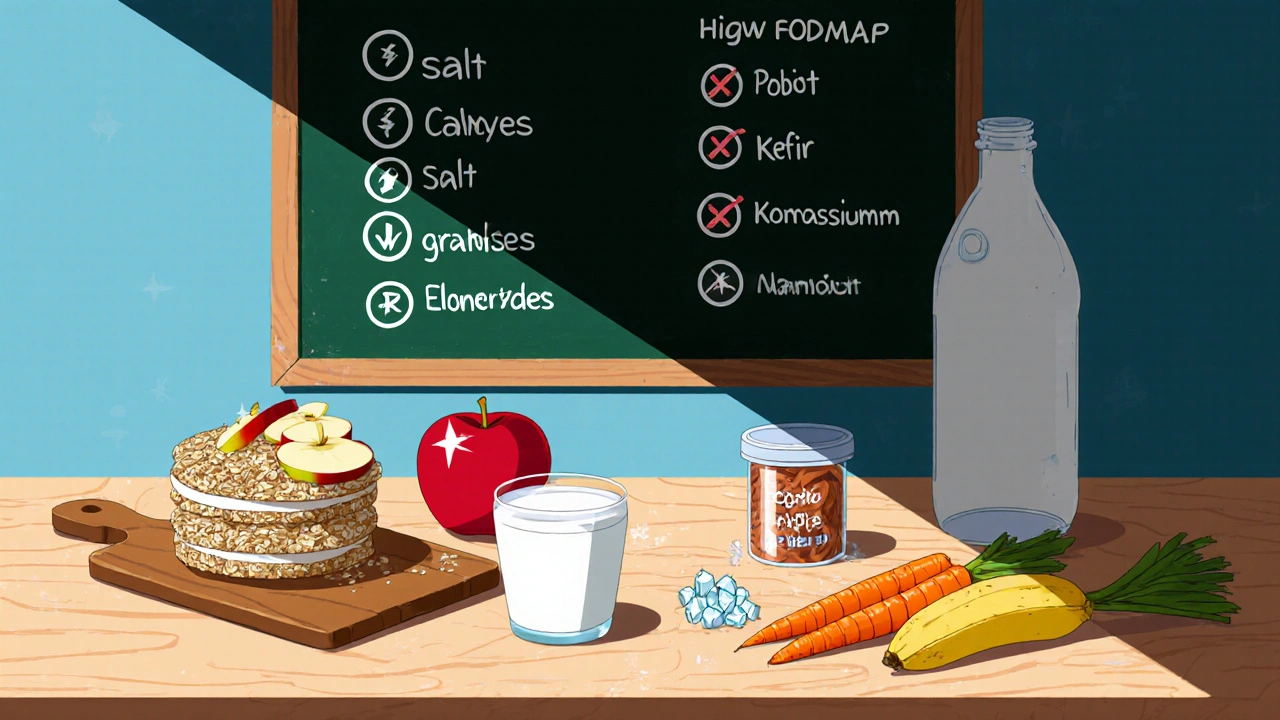Chronic Diarrhea Fiber Calculator
Calculate Your Best Fiber Approach
Select your current symptoms and dietary patterns to get personalized recommendations for managing chronic diarrhea through fiber choices.
Based on your responses, your gut likely benefits from:
- Consuming soluble fiber foods like oats, bananas, and apples
- Limiting insoluble fiber sources like bran and raw vegetables
- Considering BRAT diet during flare-ups
Your Action Plan:
- Include 2-3 servings of soluble fiber daily (e.g., ½ cup oatmeal)
- Avoid high-FODMAP foods like beans and onions during flare-ups
- Consider probiotic foods like plain yogurt
When you’re constantly dealing with chronic diarrhea, food choices become more than just a matter of taste. A balanced diet can calm the gut, replenish lost nutrients, and reduce the frequency of loose stools.
What is chronic diarrhea?
Chronic diarrhea is defined as three or more loose stools per day that persist for more than four weeks. Common causes include irritable bowel syndrome, inflammatory bowel disease, infections, malabsorption, and side‑effects from medications. The condition leads to dehydration, electrolyte loss, weight loss, and a disrupted gut microbiome.
Why nutrition matters
Food directly interacts with the intestine, influencing water absorption, motility, and bacterial balance. A balanced diet provides the right mix of macronutrients, fiber, electrolytes, and bioactive compounds that support intestinal health and prevent the cascade of fluid loss that fuels chronic diarrhea.
Key components of a gut‑friendly diet
Below are the nutrients and food groups that have the strongest evidence for helping manage chronic diarrhea.
- Fiber: Soluble fiber (found in oats, apples, carrots) forms a gel that slows transit and absorbs excess water. Insoluble fiber can worsen symptoms for some people, so it’s usually limited.
- Probiotics: Live cultures such as Lactobacillus rhamnosus GG and Bifidobacterium lactis restore a healthy gut microbiome, reducing stool frequency.
- Prebiotics: Non‑digestible carbs like inulin and resistant starch feed good bacteria. Small servings of garlic, onions, and chicory root are effective.
- Electrolytes: Sodium, potassium, and magnesium replace what’s lost in stool. Oral rehydration solutions or homemade drinks with a pinch of salt and a splash of fruit juice work well.
- Low‑FODMAP foods: Fermentable Oligo‑, Di‑, Monosaccharides And Polyols can pull water into the bowel. Limiting high‑FODMAP items like wheat, beans, and certain fruits can cut down on loose stools.
- BRAT diet basics: Bananas, Rice, Applesauce, and Toast provide bland, low‑fiber calories that are easy on the gut during flare‑ups.
- Trigger avoidance: Gluten, lactose, caffeine, and alcohol can irritate the lining and should be tested individually.

Comparison: High‑fiber vs low‑fiber foods for chronic diarrhea
| Food Category | Fiber Type | Typical Effect | Sample Items |
|---|---|---|---|
| High‑soluble | Soluble | Bulks stool, absorbs water | Oatmeal, peeled apples, carrots |
| High‑insoluble | Insoluble | Speeds transit, may increase looseness | Whole wheat bread, bran, raw vegetables |
| Low‑fiber (BRAT) | Minimal | Gentle, reduces bulk | White rice, bananas, toast |
Sample 1‑day meal plan
- Breakfast: Cream of rice cooked with a pinch of salt, topped with a sliced banana and a spoonful of plain yogurt containing live cultures.
- Mid‑morning snack: A small glass of oral rehydration solution (½ L water + ¼ tsp salt + ½ tsp sugar) and a handful of unsalted pretzels.
- Lunch: Grilled chicken breast, white rice, and steamed carrots. Add a drizzle of olive oil for healthy fat.
- Afternoon snack: Rice crackers with a thin spread of almond butter (if tolerated) and a cup of herbal tea (peppermint).
- Dinner: Baked white fish, mashed potatoes (no skin), and a side of zucchini sautéed in a small amount of butter.
- Evening: A cup of lactose‑free kefir or a probiotic drink, followed by a small piece of ripe papaya for digestion.
Practical tips for everyday life
- Shop the perimeter: Fresh meat, dairy alternatives, fruits, and vegetables are less processed and easier to control.
- Read labels: Look for “low‑FODMAP”, “no added fiber”, or “lactose‑free”.
- Prep in bulk: Cook a large pot of white rice or quinoa and freeze portions for quick meals.
- When eating out: Choose grilled or baked proteins, plain starches, and ask for sauces on the side.
- Track triggers: Keep a food diary for two weeks, noting symptoms, foods, and timing. Patterns often emerge.

Common pitfalls and how to avoid them
Many people think “more fiber is always better.” In chronic diarrhea, excess insoluble fiber can aggravate symptoms. Also, over‑reliance on sugary sports drinks may worsen diarrhea because of osmotic effects. Finally, cutting out all fiber can lead to nutrient gaps; balance is key.
When to seek medical help
If you notice blood in stool, unexplained weight loss over a month, fever, or dehydration signs (dry mouth, dizziness, reduced urine output), contact a healthcare professional. Persistent electrolyte imbalances may require prescription‑strength rehydration solutions or medication adjustments.
Quick reference checklist
- ✅ Aim for 25‑30 g of soluble fiber per day.
- ✅ Include a probiotic source with at least 10 billion CFU daily.
- ✅ Replace lost electrolytes with oral rehydration solution.
- ✅ Limit high‑FODMAP foods during flare‑ups.
- ✅ Keep a food‑symptom diary.
Can I eat fruit if I have chronic diarrhea?
Yes, but choose low‑FODMAP, low‑fiber options such as ripe bananas, canned peaches in juice, or small portions of papaya. Avoid high‑sugar fruits like mangoes and apples with skin.
How much water should I drink each day?
Aim for at least 2 liters of fluid, but increase intake if stools are watery. Include oral rehydration solutions to replace sodium and potassium.
Are probiotic supplements necessary?
They can be helpful, especially strains proven for diarrhea such as Lactobacillus rhamnosus GG. Choose products with ≥10 billion CFU and a guarantee of live cultures until expiration.
What’s the difference between the BRAT diet and a low‑FODMAP diet?
BRAT is a short‑term, bland approach useful during acute flare‑ups. Low‑FODMAP is a longer‑term elimination protocol that targets fermentable carbs that draw water into the gut.
Should I avoid all dairy?
Lactose can be a trigger for many, but fermented dairy like kefir or lactose‑free yogurts provide probiotics and calcium without the trouble.





Wow, you finally realized that binge‑eating chips won’t magically fix chronic diarrhea – shocker!
Instead of treating your gut like a dumpster, try loading up on soluble fiber like oatmeal and peeled apples; they actually form a gel that slows transit.
Don’t forget electrolytes – a pinch of salt in water isn’t just for flavor, it’s a lifesaver when you’re losing potassium with every visit to the bathroom.
Probiotics are not just hype; strains like Lactobacillus rhamnosus GG have real data backing their ability to calm the microbiome.
If you’re tempted to reload on high‑FODMAP foods, remember they draw water into the colon, which is the last thing you need.
And yes, the old BRAT diet isn’t a punishment, it’s a temporary sanctuary while you reset your system.
Stay consistent, track your triggers, and you’ll see a drop in those dreaded loose stools.
Bottom line: balance, not banishment, wins the day.
My dear, while the scientific foundations are undeniably sound, elegance in dietary execution is equally paramount.
Consider integrating hand‑selected heirloom carrots, gently stewed to preserve their pectin, which subtly enhances the soluble fiber content.
A modest splash of cold‑pressed olive oil not only provides monounsaturated fats but also imparts a soothing mouthfeel that many find comforting during flare‑ups.
In the realm of probiotic selection, I favor multi‑strain formulations that echo the complexity of a well‑curated literary anthology.
Remember, the palate deserves refinement even when the gut is on a delicate mission.
Oh, look, another “miracle diet” that promises to turn your bathroom trips into a pleasant stroll in the park.
Let’s be real: swapping your favorite pizza for bland rice and toast isn’t exactly a culinary revolution, it’s more of a forced exile.
Sure, adding a probiotic capsule might sound fancy, but without proper strain verification you’re just swallowing a placebo with a pricey label.
And the low‑FODMAP hype? It’s just another buzzword that forces you to become a part‑time nutritionist while your body does the heavy lifting.
You’ll probably end up missing your favorite foods and still be stuck on the porcelain throne.
Enjoy the journey, dear reader.
Sounds like a solid plan.
From a pathophysiological perspective, chronic diarrheal states are best conceptualized as a dysregulated osmotic gradient coupled with impaired entero‑endocrine signaling.
In this context, the therapeutic index of soluble polysaccharides-particularly β‑glucans derived from oat extracts-lies in their capacity to augment intraluminal viscosity, thereby attenuating rapid transit times.
Concurrently, the modulation of gut‑associated lymphoid tissue (GALT) via targeted probiotic strains, such as Lactobacillus rhamnosus GG and Bifidobacterium lactis, orchestrates a rebalancing of the microbiome’s alpha‑diversity metrics, which has been correlated with decreased stool frequency in randomized controlled trials.
Electrolyte restitution should not be relegated to ad‑hoc oral rehydration solutions; a stoichiometrically balanced Na⁺/K⁺/Mg²⁺ formulation calibrated to an osmolarity of ~300 mOsm/L is optimal for restoring plasma homeostasis.
The low‑FODMAP paradigm, while empirically validated in IBS cohorts, must be contextualized within the broader framework of carbohydrate malabsorption syndromes, recognizing that selective fermentable oligosaccharides can exacerbate luminal osmotic loads.
Furthermore, the BRAT protocol-though ostensibly antiquated-serves as a pragmatic caloric bridge during acute exacerbations, providing readily absorbable monosaccharides with minimal fermentative potential.
It is imperative to eschew indiscriminate fiber augmentation; insoluble cellulose, for instance, can precipitate a hypermotile response via mechanoreceptor activation in the enteric nervous system.
From a clinical algorithm standpoint, a stepwise approach encompassing dietary log analytics, targeted macronutrient reallocation, and microbiome‑centric adjuncts yields the highest probability of sustained remission.
In practice, this translates to a daily intake of approximately 25‑30 g of soluble fiber, bifidogenic prebiotic supplementation (e.g., inulin at 5 g/day), and periodic reassessment of trigger foods through elimination challenges.
Adherence metrics can be enhanced by integrating digital health platforms that automate symptom‑food correlation matrices, thereby reducing recall bias.
Ultimately, the convergence of nutraceutical precision, electrolyte stewardship, and behavioral modification constitutes the cornerstone of effective chronic diarrhea management.
Neglecting any of these pillars inevitably compromises therapeutic efficacy and may precipitate secondary complications such as micronutrient deficiencies or electrolyte derangements.
Therefore, a holistic, evidence‑based dietary regimen is not merely advisable-it is indispensable for long‑term gut homeostasis.
Wow, you really think that a 1,200‑word dissertation will convince people to swap their fries for oat bran?
In reality, most patients just need a practical, no‑nonsense plan, not a PhD thesis on fiber mechanics.
Besides, the “optimal osmolarity” you quote is something a lab tech worries about, not a person trying to avoid the bathroom.
Keep it simple, dude.
Ever notice how the same big pharma companies push sugary electrolyte drinks right when they market “gut‑health” probiotics? It’s a classic distraction technique.
They want you to think you’re fixing the problem while you’re actually loading up on hidden sugars that worsen osmotic diarrhea.
If you look at the ingredient lists, you’ll see high‑fructose corn syrup masquerading as “flavor enhancer.”
Don’t be fooled – stick to a homemade oral rehydration solution with just salt, potassium chloride, and a splash of natural juice.
That’s the only way to keep the corporations from profiting off your misery.
True, the market is saturated with over‑engineered products that promise miracles but deliver extra carbs.
However, not every electrolyte drink is a conspiracy; many are formulated for athletes who need rapid replenishment.
When you need a controlled solution, the classic WHO‑style mix – 1 L water, 6 g glucose, 2.5 g sodium chloride, and 1.5 g potassium chloride – works flawlessly.
This avoids the hidden sugars while still delivering the necessary ions.
Just remember to adjust the glucose concentration if you’re sensitive to osmotic shifts.
Listen up, folks – the Western diet propaganda machines have been weaponizing our intestines for decades.
They push high‑fiber “health” foods that are actually designed to destabilize the gut of anyone not buying their supplements.
Our traditional cuisines, rich in fermented dairy and modest starches, naturally balance electrolytes and support a resilient microbiome.
Stop falling for the “low‑FODMAP” hysteria; it’s just another export of the diet‑industrial complex.
Reclaim your culinary heritage and give your gut the home‑grown nutrients it deserves.
Only then will you truly control your bowel health.
😂 Absolutely love the passion, Jasmina!
But didn’t you just say “high‑fiber health foods” are a weapon? 🤔 Those same fibers, when chosen wisely, can be the shield that steadies the gut.
Let’s celebrate the best of both worlds – traditional fermented delights 🌾 and scientifically backed soluble fibers.
Balance is the real hero here, not the hype.
Keep the conversation rolling! 😊
Remember, every small dietary tweak is a step toward reclaiming comfort and confidence in daily life.
Think of your gut as a garden; gentle watering (electrolytes) and thoughtful planting (soluble fiber) yield a thriving ecosystem.
Even on tough days, staying consistent with a simple probiotic can spark a cascade of positive changes.
Celebrate each improvement, no matter how minor – progress is progress.
With patience and perseverance, you’ll soon find yourself less tethered to the bathroom.
Oh, please, that garden analogy is just fluff. Real results come from cutting out everything that ferments, not sprinkling a few “probiotic” pills on top.
If you want a true reset, go hardcore low‑FODMAP for a month and eliminate all dairy, grains, and even some vegetables.
The data shows that only a strict elimination can expose the hidden triggers lurking in your diet.
Your “small tweaks” are just a comfort zone for the weak‑hearted.
Stop sugar‑coating the science and just do the hard work.
i think we shuld alwasy remeber that diet is not a one size fits all.
some pepple find brad diet works while others need more fibre cras.
its all about listenning to your boddy and adjust accordinly.
dont forget the electrolytes or u will feel wrong.